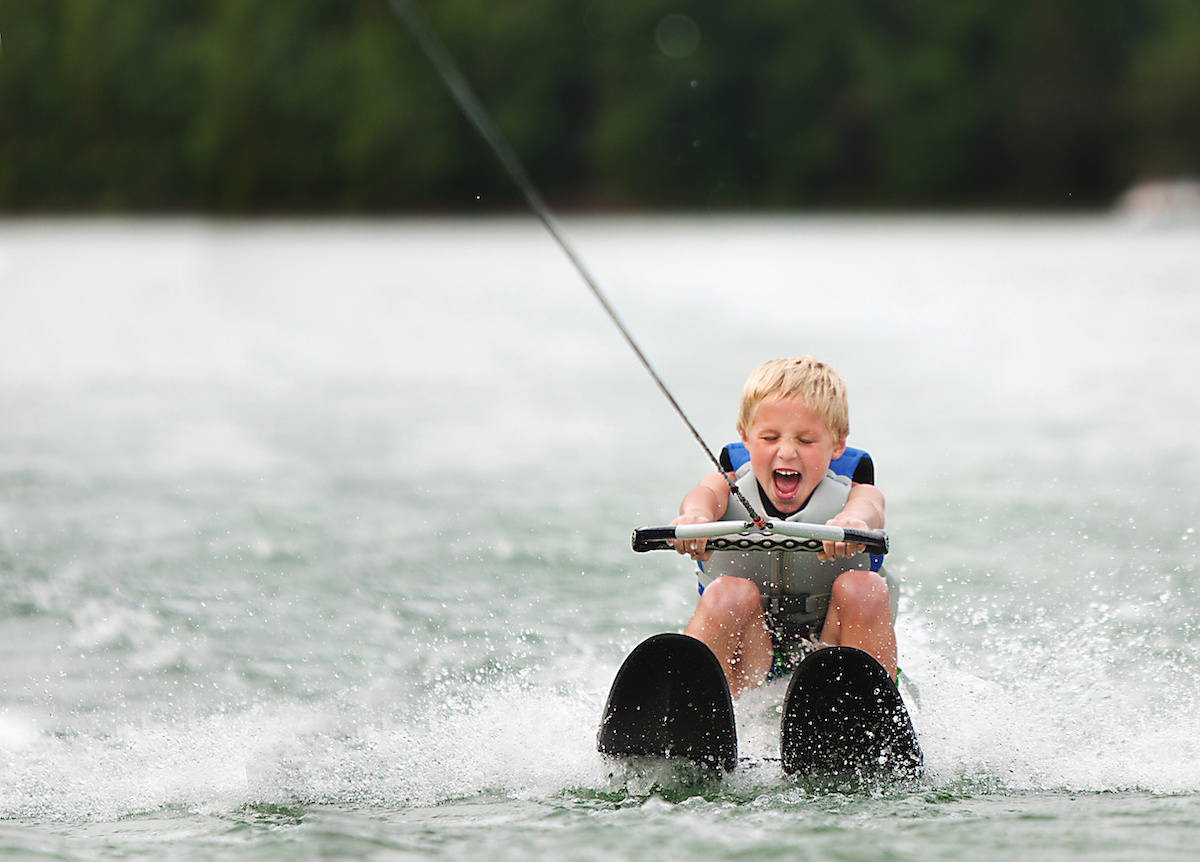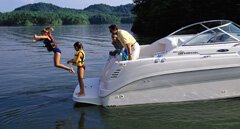Anybody who has ever watched a water ski show or competition has had the urge to go water skiing. The first towed sport in what has become an industry unto itself, water skiing has spawned offshoots such as slalom, trick and ski jumping, wakeboarding and wakesurfing, and even tubing and kneeboarding. It all started behind a boat with a guy with two boards strapped to his feet. Today, the state of the art is the result of a century of progress and innovation.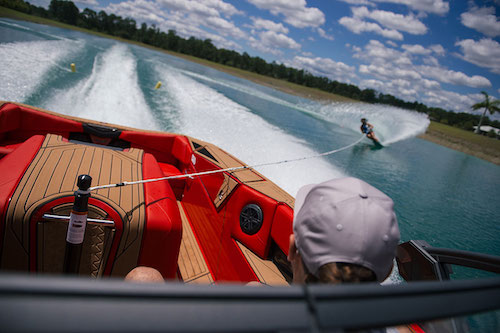
If you're interesting in learning how to water ski, be sure to follow these basic steps to help you get started.
How to Get Up on Water Skis
- Begin with a deep-water start, with your legs together.
- Let the boat do the work—stay in a crouched position until you're up on a plane.
- Once you're up, straighten your legs.
- Coach your boat driver on the proper speed for towing—around 30 MPH for water-skiers.
- Once you feel comfortable on two skis, you can transition to slalom-style skiing by dropping one ski.
Explore Ski Boat/Wake Boat Types
With kids, the best water skiing tip is to start with the skis that are tied together with nylon rope. This keeps their legs together, and keeps them from doing a split as soon as they get on plane—then doing a face-plant. Even adults first learning to ski can feel like their being split from the groin up. Skiing on two skis will work muscle groups in your legs and back that don’t normally see that much stress.
The hardest part of skiing is the hardest part of any water sport, and that’s the deep-water start. The important thing is to let the boat do the work. Trying to stand up too quickly makes things more difficult than they need be. Stay in the crouched position until you’re up on plane, then straighten your legs.
Of course, we all want to go water skiing with one ski. One good way to learn is to get up on two skis and then drop one. If you’re on a lake or lagoon, just remember where you left the ski. If you’re skiing on a river, take the current into account when you go back to try to find the other one. This gets you accustomed to slalom-style skiing, and getting up in a deep-water start on two skis is much easier than trying to get up on one ski. Deep-water starts on a single slalom ski are more difficult, and that’s where the deep-V-handle ski rope can help.
Once you’re up and running, the average water ski speed is around 30 MPH. Competition speed for pro slalom skiers is 36 MPH, but you can signal to your driver what speed your comfortable with.
Wake Skiing Equipment
Like any other towed sport, water skiing requires a fair amount of gear. To get out on the water and enjoy the sport you need at least the following four items:
- Boat
- Water ski rope and handle
- Water skis
- Life jacket or PFD (personal floatation device)
Obviously, you need a boat to learn to water ski, or at the very least a friend with a boat, right? Some are better than others, and we’ll get to that in a bit. You’ll also need some water skiing equipment.
Let’s start with water ski rope, which is a specific kind of rope. Water ski ropes have floating handles of various designs, and some measure of “give” to them, which means they stretch a bit when there is a skier in tow. For beginners just learning the deep-water start on one ski, the deep-V water ski handle is a must. The deep V lets you put the single ski right in front of you and it helps keep the ski pointed dead ahead when the boat begins to accelerate. As your skills improve, you won’t need a deep V, but you might want to advance to a slalom rope, which has colored sections to help you keep track when start skiing slalom at shorter rope lengths.
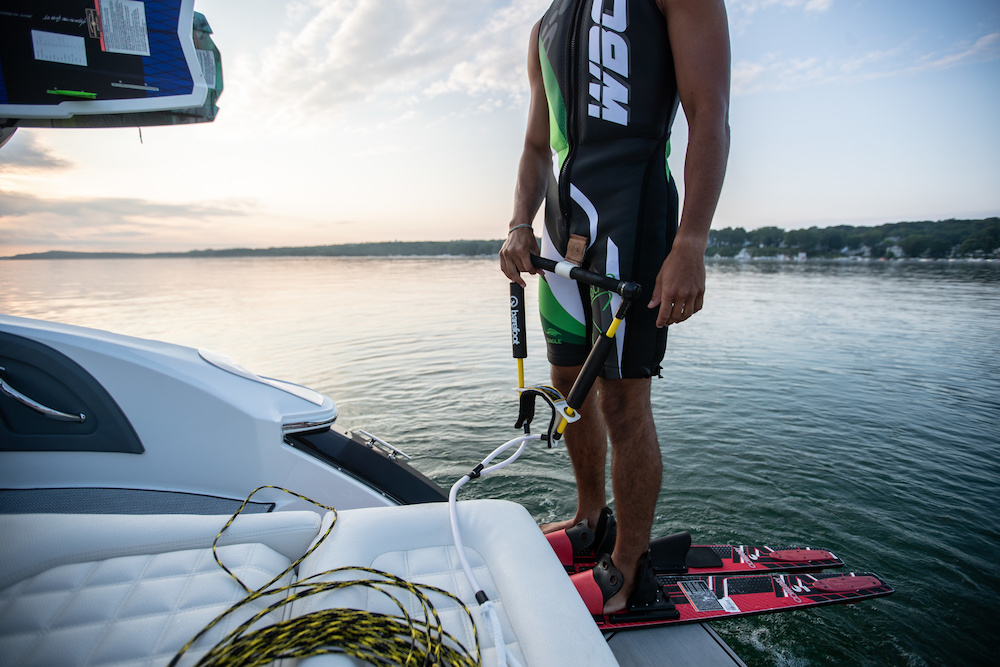
Obviously you’re also going to need water skis, and this is where things can get pricey. Luckily for beginners, skis geared toward novices are among the least expensive on the market. A pair of skis from a name brand manufacturer can run anywhere from $250 to $500 or so. More advanced skis can run upward of $1,800 a pair, but also as little as $500. Bear in mind you don’t have to have the best water skis when you’re first starting out. Learn more by reading How to Buy Water Skis.
The last essential water ski accessory is the life jacket, and the current generation is more comfortable than ever. Pricey vests can run a little more than $100, but don’t be afraid to spend more for a PFD that fits well. Bright colors are also a good idea for making a downed skier in the water more visible.
Life Jackets, Vests & PFDs: How to Choose the Right Fit
What Type of Boat Do You Need to Water Ski?
The reality is you don’t need a tournament boat to learn to water ski, but it helps. Seriously, you can learn to ski behind almost anything, the operative word being “almost.” You should have a V-hull boat with a decent amount of power. Pontoons or other low-power outboard driven boats make things more difficult if not impossible for the skier, particularly if he or she is new to the game.
Lots of tow boat builders make “multi-sport” boats that are good for wakeboarding and wakesurfing, but also skiing. At the top of the game lie the tournament inboards, which have the engine located in the middle for even weight distribution and hulls designed to create flat wakes that make it easier to cut across behind the boat.
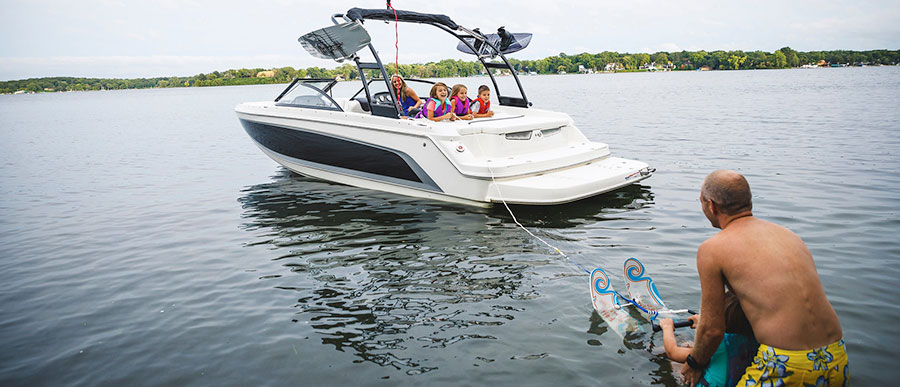
The ski shows and competitions you saw when you were little inspired you to go water skiing. There is a learning curve to it, but it’s just as much fun as you think it is, and it’s a hobby you can participate in for a long time. All you need is some warm weather, some free weekends with your family and the right equipment. What could be better than that?
Find Out More About Watersports Boats
Frequently Asked Questions
Which is a recommended water skiing safety practice?
Safety is critical, so it’s important to have a few basics covered.
- Be sure you and your driver have an agreed-upon set of hand signals. Thumbs up to go faster, down for slower, the OK hand signal to indicate the speed is right. There are other signals such as patting the head to indicate you’re finished or want to get back on the boat.
- Always wearing a life vest, skiers and drivers should always be aware of their surroundings.
- Having an observer and a driver on board is much safer than just having a driver with a ski mirror.
To learn more, be sure to refer to our Watersports Safety Guide.
How to slalom water ski?
For people just starting out, there’s a ski rope with a deep V that helps with deep water starts. You just put the tip of the ski inside the V of the rope, and that helps the ski remained pointed forward as the boat is taking off. The training rope helps a lot because doing a deep-water start on a single ski is not easy. The same logic applies: Let the boat do the work to get you on plane before you try to stand up.
What water skis should I buy, or how do I choose water skis?
Skis are designed and built for people depending on their level of experience and their weight. Typically, they are sold in three categories: beginner, intermediate and advanced, and by weight. The heavier the skier, the longer the ski.
How long are water skis?
Adult skis are typically 63- to about 72-inches long. Skis for children are obviously shorter.
How do I teach a kid to water ski?
With kids, it’s best to start with the skis that are tied together with nylon rope. This keeps their legs together, and keeps them from doing a split as soon as they get on plane—then doing a face-plant. Kids need early successes to have fun, and having fun is what will keep them interested.
How do I teach someone to water ski?
There are schools around the country that teach water skiing, but you don’t have to go to a professional school to learn to ski. Almost any experienced skier can teach another person to ski. The key to offering tips and corrections is to put them in between compliments. For example, tell them what they did right, offer corrections, then offer another compliment. That keeps the student in high spirits while he or she is learning.
How do I tie water ski rope?
If your boat has a tow pylon, push the rope through the loop at the end of the rope and wrap the loop that creates around the pylon. This allows the rope to tighten when a skier is in tow. If you have a tow eye, twist the loop on the end of the rope to create a figure 8, then fold the 8 over itself and put both loops over the pin in the middle of the tow eye.
How do I find water skiing near me?
Here at Discover Boating, we have a top 10 list of water ski schools, but there really isn’t an online database of slalom course locations. The best thing to do is to ask a local retailer. You can make your own course with kits available from major retailers like Bass Pro Shops or Cabela's. Plus, there are a lot of resources online for building your own course.
You Might Also Like:
